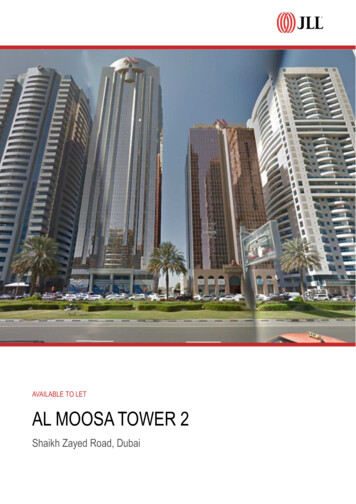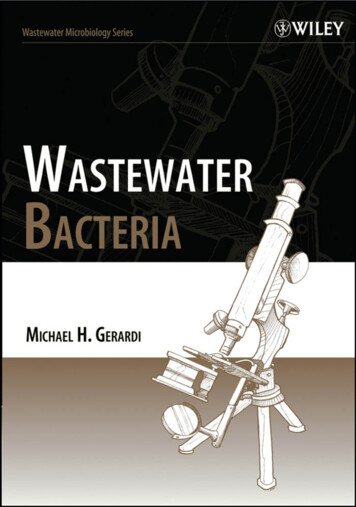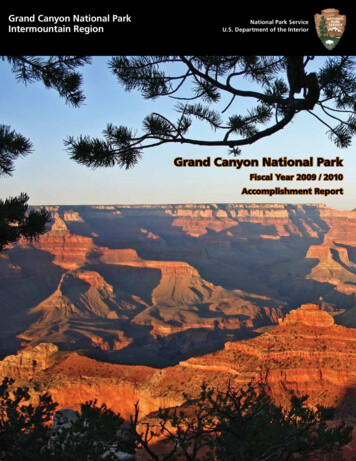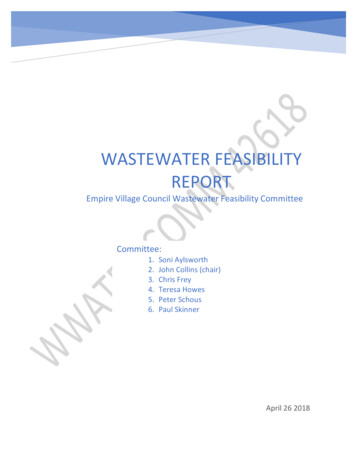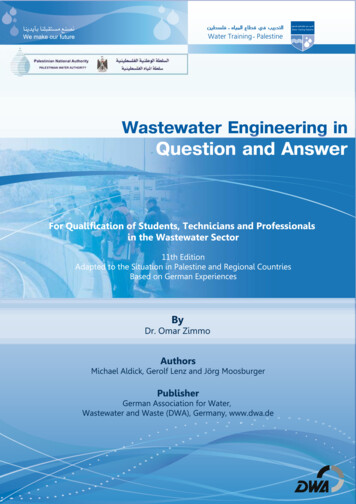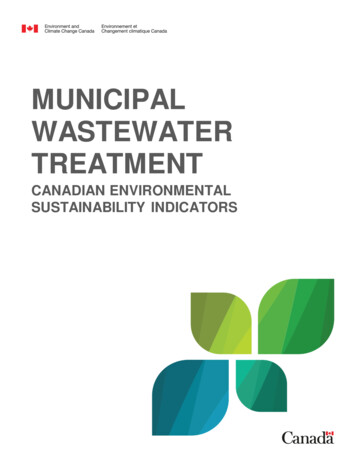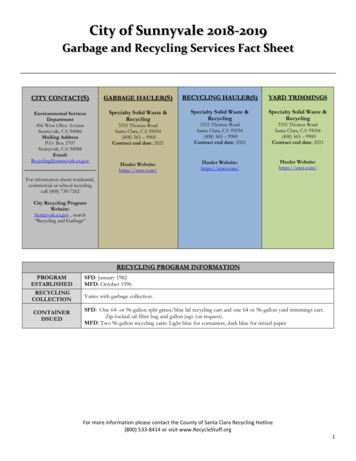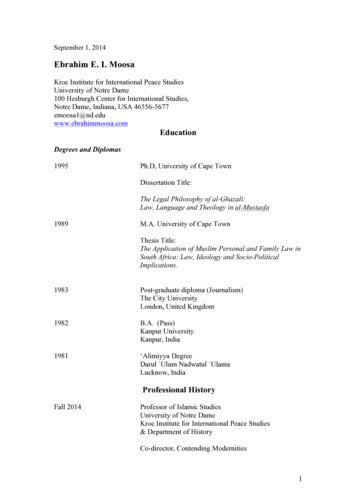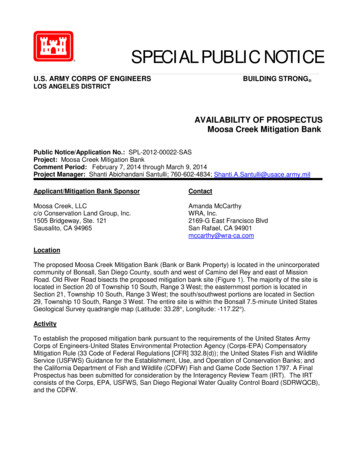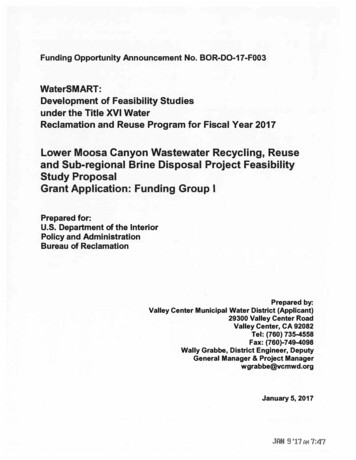
Transcription
Funding Opportunity Announcement No. BOR-D0-17-F003WaterSMART:Development of Feasibility Studiesunder the Title XVI WaterReclamation and Reuse Program for Fiscal Year 2017Lower Moosa Canyon Wastewater Recycling, Reuseand Sub-regional Brine Disposal Project FeasibilityStudy ProposalGrant Application: Funding Group IPrepared for:U.S. Department of the InteriorPolicy and AdministrationBureau of ReclamationPrepared by:Valley Center Municipal Water District (Applicant)29300 Valley Center RoadValley Center, CA 92082Tel: (760) 735-4558Fax: (760)-749-4098Wally Grabbe, District Engineer, DeputyGeneral Manager & Project Managerwgrabbe@vcmwd.orgJanuary 5, 2017JAN 9 '17 AM 7:47
TABLE OF CONTENTSMANDATORY FEDERAL FORMSTITLE PAGETABLE OF CONTENTSTECHNICAL PROPOSALExecutive Summary . . 1Study Description.1Evaluation Criteria .Criterion 1: Statement of Problems and Needs .Criterion 2: Water Reclamation and Reuse Opportunities .Criterion 3: Description of Potential Alternatives .Criterion 4: Stretching Water Supplies .Criterion 5: Environment and Water Quality .Criterion 6: Legal and Institutional Requirements .Criterion 7: Renewable Energy and Energy Efficiency .Criterion 8: Watershed Perspective .131315151718181920STUDY BUDGETFunding Plan and Letters of Project Support .Table 1 - Summary of Non-Federal and Federal Funding Sources .Budget Proposal .Table 2 - Budget Proposal . .Budget Narrative .Exhibit D - Projected Fringe Benefits 2016-2017 .Table 3 - Technical Project Report Budget Summary .21232324252627LETTERS OF PROJECT SUPPORTDRAFT OFFICIAL RESOLUTION
TECHNICAL PROPOSAL: EXECUTIVE SUMMARYTitle:Lower Moosa Canyon Wastewater Recycling, Reuse and Sub-regional Brine DisposalProject Feasibility Study ProposalDate:January 5, 2017Applicant:Valley Center Municipal Water DistrictValley Center, San Diego County, CaliforniaSummary of the ProposalA one paragraph project summary that identifies the proposed work, including how funds will be used toaccomplish specific feasibility study activities and briefly identifies how the proposed feasibility studycontributes to accomplishing the goals of this FOA.Valley Center Municipal Water District (VCMWD) in Valley Center, San Diego County, California, isproposing to study the feasibility of various options for re-using the effluent from its Lower MoosaCanyon Water Reclamation Facility (LMCWRF), as well as options for developing a brine disposal pipelineto serve surrounding agencies. The funds will be used to hire consultants to: 1) examine/review variousre-use approaches including Indirect Potable Reuse (IPR), agricultural re-use, and golf course irrigation;2) develop feasible brine pipeline routing alternatives; 3) review groundwater basin conditions/characteristics, 4) identify environmental issues/concerns associated with the alternatives; 5) identifyregulatory requirements and approaches to enhancing re-use feasibility; and 6) manage thedevelopment of the overall feasibility report including monitoring of budget, schedule and content.District staff will develop community outreach approaches necessary to promote public acceptance andimplementation of viable alternatives. This project will serve the goals of this Bureau of Reclamation FOAby providing a reuse project for effluent that is currently put to no beneficial use, as well as providing abrine pipeline that would promote the development of demineralization-oriented IPR, reuse andimpaired groundwater reclamation projects in the region which may include at least two Tribal lands. Inkeeping with the Interior's goal of achieving a sustainable water strategy, this project will create anoverall template for smaller inland water agencies to follow in the development of such reclamation andreuse projectsLength of Time/Estimated Completion Date for Proposed Feasibility StudyIt is estimated that the feasibility study can be completed in 10 months, by October 31, 2017.TECHNICAL PROPOSAL: STUDY DESCRIPTIONThe technical study description should describe the work in detail including specific activities that will beaccomplished. This description should have sufficient detail to permit a comprehensive evaluation of theproposal. The study description should address the requirements of a Title XVI feasibility study describedin Section 4.B of the Reclamation Feasibility Study Directives and Standards.The requirements put forth in Section 4.B will be stated below in "italics" and identified by their"4.B." outline numbering (1) through (10).Section 4.8. {1} Introductory Informationa. Identification of the non-Federal project sponsor(s).VCMND FOA No. BOR-D0-17-F003 Application, Page 1
The non-federal project sponsor is: Valley Center Municipal Water District (VCMWD) in Valley Center, San Diego County, CAb. "A description ofthe study area and an area/project map.The study area is in North San Diego County, California, and includes Valley Center, and portions ofFallbrook, Bonsall, Rainbow, and the City of Escondido. This broader area is depicted in Exhibit 1. A morefocused portion of this study area is presented in Exhibit 2 which sites the Lower Moosa CanyonWastewater Treatment Plant and their associated percolation ponds. The topography of the area isgenerally hilly with some flat areas. Variations in elevation range from approximately 200 feet to over1600 feet MSL.c. "A definition of the study area in terms of both the site-specific project areas and where thereclaimed water supply will be needed and developed, and any reclaimed water distributionsystems.Agricultural Reuse Distribution. Exhibit 2 provides the location of potential agricultural recycled waterusers. Essentially, farms north of the LMCWRF would be the study targets for developing estimates ofwhere the reclaimed agricultural water supply would be needed. As shown conceptually in "brown" inExhibit 2, the potential distribution systems would be established in existing road rights-of-way.Operational storage might be sited on an existing reservoir site. Locations and sizing for wet weatherstorage would be identified during the study. Recycled water from the LMCWRF also has the potential tobe put to direct beneficial agricultural and irrigation use in VCMWD and two adjacent water districts:RMWD and VWD.Golf Course Irrigation Distribution. Exhibit 2 presents the location of a golf course adjacent to theLMCWRF plant site. The recycled water distribution system may be located in private easements, giventhe proximity of the golf course, but advantages of locating the system in public right-of-way will beexamined during the study. Siting of seasonal storage presents a significant issue to be examined throughreview of nearby terrain, as well as discussions with the golf course owners.Title 22 Treatment. The location at which Title 22 recycled water will be developed will be the LowerMoosa Canyon WRF (LMCWRF) plant site. This site presently has secondary treatment processes featuringbiological nutrient removal. An aerial photo of the existing plant is presented in Exhibit 3. It is anticipatedthat the Title 22 treatment facilities would be located in the easterly portion of the plant.IPR/DPR Treatment. These facilities may be located at the LMCWRF plant site or elsewhere proximal toMoosa Creek. Their location will be impacted by the characteristics of the groundwater basin coupled withinput and direction from the Regional Water Quality Control Board (RWQCB) and Division of DrinkingWater (DDW) concerning configuration of the treatment system and distribution system interface.Brine Disposal. Valley Center Municipal Water District will be working in conjunction with Fallbrook PublicUtilities District, Yuima Municipal Water District, Rainbow Municipal Water District, Rincon del DiabloMunicipal Water District, and the City of Escondido (collectively, the "Supporting Agencies") to determinethe feasibility of a Regional Brine Pipeline to serve surrounding agencies including at least two Tribal lands.The pipeline would be used in conjunction with future projects involving demineralization and generationof brine waste such as Indirect Potable Reuse (IPR), Direct Potable Reuse (DPR), and reclamation ofimpaired groundwater basins. Exhibit 1 - Regional Brine Disposal Alternatives presents the concept of thepipeline. The brine pipeline will convey the high TDS waste from demineralization systems to the existingbrine outfalls in either FPUD or Escondido. The existing outfalls currently discharge to the ocean fordisposal. The Regional Brine Pipeline is a critical element that overcomes a fatal flaw in projectdevelopment for demineralization projects at inland water/wastewater agencies.VCMND FOA No. BOR-D0-17-F003 Application, Page 2
WDYUIMAMWDi.,. ,rj-!Concept PlanNorthern Option- Southern OptionExistingExisting BrinePipeline-c:JLower MoosaCanyonWRFVCMWD BoundaryE22J 1ndian ReservationVALLEY CENTERMUNICIPAL WATERDISTRICTSub-Regional Brine DisposalAlternatives Concept PlanExhibit aDispAtt P.mxdSource: SanGIS. SANDAG, SDCWA. VCMWD
---(IReservoir1::::::I PercPonds- Lower MoosaCanyon WRF,J, Moosa Boundary['.:J VCMWD BoundaryGolf CourseQ!!lmilRainbow MWDDCJ Valley Center MWDVA LLEY CENTERL WATERMUNIClRSTDIAltR lamationmat1ve ComExhibit 2 ponentsclaY:IGISProjects\RleclWater\Re sSource.· IS, SANDAG,12129/2016-P.mxd,VCMWD
VALLEY CENTERMUNICIPAL WATERDISTRICTExisting Lower Moosa CanyonPlant Aerial ViewExhibit n PmxdSourca: SanGIS, SANDAG, SDCWA, VCMWD
Section 4.B. (2) Statement of Problems and Needs(a) Description of the problem and need/or water reclamation and reuse projectThe regional needs for the project are centered on the history of long-term droughts in this region, thecontinuing drought, and the desire to reduce dependence on imported water deliveries while developingdrought-tolerant, reliable and sustainable sources. Water in southern California is in critically shortsupply. Currently, the entire State has endured five years of severe drought. Access to traditionalCalifornia Bay Delta/Colorado River supplies is being limited by growing needs in the areas of origin, otherstates, and regulatory measures to protect the riverine species and habitats. Given these challenges,public water agencies must focus on developing new, alternative local supplies to offset reductions inimported water and provide adequate, affordable and secure supplies for their respective communities.In the sub-region involved in this project, there has been a steady decline in agriculture, related to thelack of a reliable and affordable water supply. The vast majority of water to this sub-region is imported, anotable exception being the costly water produced by the recently completed Bud Lewis Desalination Plant.This Desalination Plant has raised the cost of the next increment of water supply development, thus openingthe door to more expensive options for developing water supplies. Water reclamation and reuse projectsdescribed herein will provide needed drought-tolerant, reliable and sustainable water supply. Furthermore,an IPR/DPR project would directly develop potable water supplies that are drought-tolerant, reliable andsustainable through the conversion of wastewater to potable water. The sub-regional brine disposal projectfacilitates the development of potable water supplies both now and in the future by providing brine disposalfor the demineralization processes involved in IPR/DPR projects and projects desalting naturally impairedground-water basins.(b) Description of current and projected water supplies, including water rights, and potential sourcesof additional water, other than the proposed Title XVI project, and plans for new facilities.VCMWD's water master plan will be the source of this information. VCMWD will obtain relevantinformation from existing studies and plans developed by our potential Brine Disposal Pipeline partners.At present VCMWD has no rights to naturally occurring potable water in this watershed.(c) Description of current and projected water demands.SDCWA develops regional estimates in its Urban Water Management Plan which will be the source of thisinformation.(d) Description of any water quality concerns for the current and projected water supply.VCMWD's water master plan will be the source of this information. VCMWD will obtain relevantinformation from existing studies and plans developed by our potential Brine Disposal Pipeline partners.High TDS, boron and chloride in recycled water supplies limit its use for agriculture for many crops in thisregion. This highlights the need for demineralization treatment technologies, which are brine-producingand require a cost-effective brine disposal alternative.(e) Description of current and projected wastewaters and disposal options other than the proposedTitle XVI project, and plans for new wastewater facilities, including projected costs.VCMWD's Lower Moosa Canyon wastewater treatment plant Master Plan Update will be the source of thisinformation including the plans and costs for future wastewater facilities. We are currently aware of noother plans in our area to develop a sub-regional Brine Disposal pipeline.VCMWD FOA No. BOR-D0-17-F003 Application, Page 6
Section 4.B.(3) Water Reclamation and Reuse OpportunitiesAddress the opportunities for water reclamation and reuse in the study area, and identify the sources ofwater that could be reclaimed, including the following information.Uses. For VCMWD, potential reclamation/reuse opportunities include agricultural reuse, golfcourse irrigation, groundwater recharge, and domestic reuse {IPR). TDS, boron, chloride and nitrogen areimportant water characteristics for these uses. These uses, water quality and treatment requirements willlikely be reinforced and expanded through our discussions with neighboring agencies regarding the sub regional brine disposal pipeline.Markets. Within VCMWD, reuse markets include agricultural reuse, golf course irrigation, anddomestic reuse (IPR/DPR) with current domestic customers. Impacts and improvements through groundwater recharge/reclamation as a result of proposed projects will also be examined by the consultinggroundwater hydro-geologist. VCMWD staff assisted by consultants will use water use records todetermine potential volumes for screening of re-use opportunities, and meetings/discussions withpotential users to determine interest/needs for the reuse alternatives.Maximizing the potential sub-regional markets will require brine removal and disposal. Brine disposal willbe necessary for development of projects involving demineralization, a technology that reduces totaldissolved solids (TDS), boron, and chloride {Cr) in water. These constituents are often limiting waterquality factors in water reuse for groundwater recharge and domestic reuse as well as certain local high dollar agricultural reuse. Brine pipeline alternative routes will be examined by the design consultant.Refer to Exhibit 1 - Sub-Regional Brine Disposal Alternatives Concept Plan which shows the NorthernRoute (in orange) from Yuima MWD (YMWD) through Rainbow MWD (RMWD) and VCMWD to FPUD, aswell as the Southern Route (in green) from Yuima/VCMWD to Rincon del Diablo MWD (Rincon) and theCity of Escondido (Escondido). The brine line may also benefit two or more Tribal lands. We have spokenwith the Supporting Agencies regarding their interest in such a regional facility and have included letters ofsupport from them for this effort.Considerations. A review of considerations will be undertaken by VCMWD. These presentlyinclude water quality, public acceptance of IPR/DPR, and cost considerations. District staff will provideoutreach activities/approaches to promote public acceptance. VCMWD has implemented a recycledwater project in another area of the District and will draw on those experiences. When identified,stakeholders will be contacted to provide feedback to promote inclusion in the process. Additionalmethods of eliminating these challenges will be reviewed with other Southern California agencies such asthe City of San Diego, Orange County Water District, and Padre Dam Municipal Water District, to draw ontheir experiences as well.Agencies having jurisdiction. VCMWD and the Supporting Agencies are agencies with jurisdictionin the area that have potential projects that may require brine disposal. VCMWD is a water andwastewater agency that has jurisdiction over sources of reclaimed water.Potential water sources to be reclaimed. Besides reclaiming of wastewater effluent, impairedgroundwater in all of the regional agencies is a potential source of water to be reclaimed. For VCMWD,the groundwater basins near the LMCWRF and near the discharge percolation ponds are potentialimpaired source waters which currently have no identified beneficial uses. Also, no beneficial use is beingmade of the effluent from the existing Lower Moosa Canyon Water Reclamation Facility (LMCWRF) whichcurrently discharges 0.31 mgd to percolation ponds for disposal.Description of Source Water Facilities. VCMWD will contact the engineering/planningdepartments of the Supporting Agencies to identify their existing and future planned source waterfacilities, as well as to estimate the amount of impaired waters available to meet reclaimed and reuseVCMWD FOA No. BOR-D0-17-F003 Application, Page 7
water demands. VCMWD has no natural source water facilities, and will have the consulting groundwaterhydro-geologist identify any potential quantity of impaired groundwater available near LMCWRF.Current Water Reuse. VCMWD reuses all of the current 0.035 mgd flow from its 0.075 mgd WoodsValley Ranch WRF (WVR). Escondido creates approximately 9.0 mgd of wastewater from its HAARFTreatment Facility which it shares with Rincon. Rincon acts as a purveyor of recycled water. Lists of waterusers, the type of reuse, and maps of distribution systems and use sites for VCMWD, Rincon and the City ofEscondido will be included in the study.Current water reclamation technologies. Both the Woods Valley and HAARF facilities use Full Title22 treatment technologies. The use of TDS, boron and chloride-reducing technologies (demineralization)would expand the desirability/uses of the water into new markets of agricultural reuse and domesticreuse.Section 4.B. (4) Description of Alternatives(a) Description of the non-Federal funding condition. The reasonably foreseeable future actions that thenon-Federal project sponsor would take if Federal funding were not provided for the proposed waterreclamation and reuse project, including estimated costs.In this condition VCMWD would continue 100 percent reliance on imported and ocean desalinated waterfrom SDCWA for providing water in the area surrounding Lower Moosa Canyon Wastewater Plant.VCMWD has used imported water from SDCWA for agriculture and residential/commercial developmentfor the past 60 years. There are no imminent plans for reusing the effluent from the Lower Moosa CanyonWastewater Treatment Plant until the plant flow increases to 0.44 mgd. This approach likely will subjectgrowers to projected minimum 5-10 percent rate increases each and every year and for all VCMWDcustomers for the foreseeable future. Currently, the retail cost of imported water is roughly 1,900 peracre foot and 1,400 per acre foot for domestic and agricultural uses, respectively. While the increase ofthese rates will create a stress on domestic and commercial customers, for agricultural users thesituation is much more dire. Many have already been driven out of business. Water at the increasedprices will be unaffordable for agricultural users and drive more of them out of business. This study isgoing to determine whether the treatment and distribution systems for reused wastewater within VCMWDwould be feasible with or without Federal funding.At present there are no plans to construct a regional brine pipeline, and this study would determinewhether it would be feasible with Federal funding. The use of IPR/DPR is currently being explored byEscondido. VCMWD would be determining whether IPR/DPR is feasible with or without such funding, butpresently there are no plans to build an IPR/DPR project.(b) Statement ofthe objectives all alternatives are designed to meet.Each alternative is designed with the following objectives: Maximize the beneficial use of local non-potable sources, including recycled wastewater, non potable, ground and surface water, while facilitating the environmental benefits of reduced demandon imported water sources and reduced waste stream discharges to area aquifers and watersheds. Contribute toward the region's wholesale water supplier, the San Diego County Water Authority(SDCWA), in meeting its Water Supply Reliability and Integrated Resource Planning Goals for thedevelopment of local supplies, specifically water reclamation. Relieve demand on imported sources from the California Bay Delta and the Colorado River byexpanding VCMWD's local water supply, which is currently 100 percent dependent on importedwater and water produced from ocean desalination.VCMiND FOA No. BOR-D0-17-F003 Application, Page 8
(c) Description of other water supply alternatives considered to accomplish the objectives to be addressed by the proposed Title XVI project. VCMWD's water supply alternative is to receive additional water from the wholesaler SDCWA whichsupplies imported water and water produced by the Bud Lewis Desalination Plant.(d) Description of the proposed Title XVI project AND(I) Description of at least two alternative measures, or technologies available for water reclamation,distribution, and reuse for the project under consideration.This project is comprised of: A) VCMWD Title 22 Treatment Options; B) Title 22 Distribution SystemOptions; C) IPR/DPR Alternatives; and D) Regional Brine Disposal Options. The design consultant workingin conjunction with VCMWD staff will fulfill the life cycle costing requirements including non-constructioncosts of all of these alternatives to facilitate comparison in the required formats.A. VCMWD Title 22 Treatment OptionsAt the LMCWRF at least two treatment train options will be considered. The existing secondaryprocesses (anoxic/aerobic tanks followed by secondary clarifiers) will be supplemented by either: 1}chemical addition, filtration (disk filters), and disinfection (chlorination/UV); or 2) MBR treatment anddisinfection (chlorination/UV}. Again, life-cycle costing will be used in comparing these alternatives toassure financial sustainability of the selected projects into the future. For golf course irrigation, thesetreatment options will cover the range of alternatives considered. For agricultural reuse, water qualityrequirements may result in the consideration of blending or even a third treatment option ofdemineralization to achieve the desired user water quality.B. Title 22 Distribution System OptionsA series of alternatives will be considered for the two main Title 22 irrigation options: 1) agriculturalreuse and 2} golf course reuse. Refer to Exhibit 2.Agricultural distribution alternatives will undergo a screening that weighs the cost of the systemagainst revenues generated by the quantity of recycled water that can be distributed by thatalternative to pay for the costs. Piping networks and pump station requirements will be developed,along with operational storage and seasonal storage. Piping will preferentially be in public right-of-wayto avoid issues related to right-of-way acquisition.Golf course reuse will present pipeline and pump station options, along with potential operational andseasonal storage facilities. Due to the proximity of the golf course to the LMCWRF (See Exhibit 2}, thenumber of pipeline options to be examined will likely be limited.C. VCMWD IPR/DPR AlternativesIt is anticipated that IPR/DPR treatment will start with and consider Title 22 Treatment alternativesgiven the potential impact that an MBR facility would have on the pre-treatment requirements for ademineralization process. Demineralization processes that are currently in use for this type ofapplication will be given priority in the feasibility review, such that the successful/cost-effectivetechnologies may be limited. For IPR, options for introducing recycled water into the environment willconsider the groundwater and surface water conditions near the plant and at other injection/dischargepoints to create the most cost effective approach for this project. Pro-actively working with theRWQCB, DOW and our regulatory consultant, VCMWD will work to assure that the alternative isacceptable to regulators.VCWf,/1/D FOA No. BOR-D0-17-F003 Application, Page 9
It is anticipated that IPR/DPR options will require a tank for blending IPR water with existing domesticwater prior to introduction into the domestic system. The location of this tank and the point ofintroduction into the domestic system will be identified.O. Regional Brine Disposal Options.As presented in Exhibit 1, two conceptual alternative routes for the Regional Brine Pipeline will stretchfrom either 1} YMWD and VCMWD through RMWD to FPUD, or 2) YMWD through VCMWD and Rinconto Escondido. It is anticipated that this brine pipeline will be a small diameter pipeline conveyingquantities of brine concentrate from demineralization treatment processes. Though the distances arefairly long, preliminary cost estimates indicate that the small diameter of this pipeline makes itpotentially feasible. Preferred routes will be in public roadways to avoid right-of-way issues, though ifsubstantial savings can be realized, private easements will be considered.In parallel with consideration of the regional brine pipeline, hauling of the brine concentrate will beconsidered as an option to the regional brine pipeline.(e) Description of waste-stream discharge treatment and disposal water quality requirements for theproposed Title XVI project.Working with our regulatory consultant, VCMWD will confirm the above requirements. There areprecedence for all of the requirements. Title 22 regulations for reuse options have been in place fordecades. In 2015 IPR/DPR groundwater regulations were established. Brine disposal has been occurringin California for decades as well.Section 4.8. (5) Economic AnalysisA Title XVI feasibility study report must include an economic analysis of the proposed Title XVI projectrelative to other water supply alternatives that could be implemented by the non-Federal project sponsor.This assessment needs to identify the degree to which the water recycling and reuse alternative is cost effective, and the economic benefits that are to be realized after implementation.As VCMWD has no alternative water supplies other than buying water from SDCWA, this economicanalysis will be co.mparing the most cost effective Title XVI alternative to simply continuing to purchasewater from SDCWA. The economic analysis will examine whether there will be economic relief to thehard-hit agricultural irrigation customers or domestic users. Life cycle costs for each reuse alternativewill be examined in determining economic feasibility.Beyond economic considerations, historical records of recurring drought along with the current droughtgives greater weight to non-economic considerations such as the supply reliability measured in terms ofdrought tolerance and on-going sustainability of water supplies. This favors a reduced reliance onimported water supplies and potential improvements in groundwater quality. Any of the anticipatedalternatives will reduce the need for increasing imported water supplies.Section 4.8. (6) Selection of the Proposed Title XVI ProjectProvide a justification of why the proposed Title XVI project is the selected alternative in terms of meetingobjectives, demands, needs, cost effectiveness, and other criteria important to the decision.(a) ) Provide an analysis of whether the proposed Title XVI project would address the following:(i) ) Reduction, postponement, or elimination of development of new or expanded water supplies;(ii) ) Reduction or elimination of the use of existing diversions from natural watercourses, orwithdrawals from aquifers;VCWi/D FOA No. BOR-D0-17-F003 Application, Page 10
(iii) Reduction of demand on existing Federal water supply facilities; and(iv) Reduc;tion, postponement, or elimination of new or expanded wastewater facilities.Any of the proposed alternatives will reduce the need for new water supplies while at the same timereduce the diversions from the natural water courses that are the sources for our imported watersupplies from the California Bay Delta of the State Water Project and also from the Colorado River.As the Colorado River facilities encompass several Federal Water Supply Facilities, the proposed projectwill reduce the demand on those sources. Cost effectiveness in the sense of weighing the price that canbe charged for t
Moosa Canyon WRF (LMCWRF) plant site. This site presently has secondary treatment processes featuring biological nutrient removal. An aerial photo of the existing plant is presented in Exhibit 3. It is anticipated that the Title 22 treatment facilities would be located in the easterly portion of the plant. IPR/DPR Treatment.
